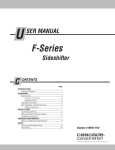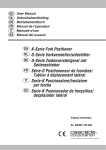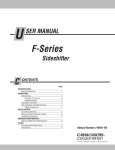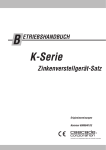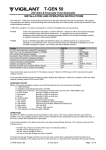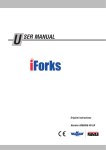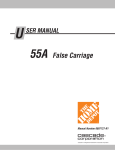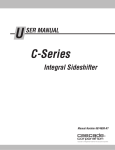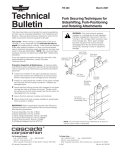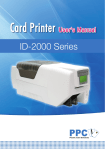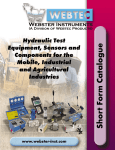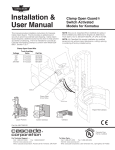Download General Fork Installation
Transcript
c Installation Instructions General Fork Installation This manual describes the installation of forks for Rotating, Sideshifting, and Fork Positioning attachments. Middle hooks must be properly welded prior to installation on rotators. Refer to the following securing procedures for driver safety and prevent load or equipment damage. WARNING: Fork locks must be properly engaged in a carriage notch for safe operation. Improper engagement may result in the fork moving on the carriage and/or excessive wear to the carriage notch. Worn upper carriage bar slots may allow fork locks to become disengaged from the notch (locked position) during use, resulting in injury or equipment damage. Fork Locks – After moving or installing forks on the sideshifter, rotator, or truck carriage, it is very important that the fork locks be fully engaged into locating notches. When loads are handled with side loading conditions, or other non-recommended uses or practices, excessive upper carriage bar notch wear may result on Cascade sideshifters. NOTE: Non-recommended practices are those not adhering to ANSI B56-1-2005 safety standards. If you are experiencing rapid carriage notch wear with a Cascade attachment, contact Cascade Customer Service. Capscrew Type Fork Keeper Lever Type Fork Keeper Knob Type Fork Lock Preventive Inspection & Maintenance – To improve safety and efficiency when using forks, make sure the following preventive inspection and maintenance is performed by trained personnel: 1 Inspect the condition of the upper carriage bar notches during the next normal truck maintenance or service period. Perform weld repairs on the carriage bars as necessary. Use wear gauge part no. 209508 (Class II), 209507 (Class III) or 6105257 (Class IV) to inspect for carriage bar. Bar Type Fork Keeper Carriage Notches Sideshifter Welded Fork Stop 2 Inspect on a daily basis the condition of the upper carriage bar notches and the fork locking mechanism. Replace any damaged parts. 3 Make sure that fork locking pins are fully engaged in the upper carriage bar notches at all times during use. Push on the fork heel to confirm that the fork does not disengage from the carriage. Third Hook (All rotators with adjustable forks) 4 Make sure that fork stops are in place and functional. 5 A third hook is always required on adjustable forks mounted on rotators. 6 Inspect forks for fork wear, at a minimum, every 12 months (single shift operations) with fork calipers (part no. 7004851) or fork inspection safety kit (part no. 3014162). Inspect forks as outlined in "Periodic Maintenance" section, page 9. NOTE: Adjust inspection period for multiple shifts. GA0382.eps Part Number 6072127-R5 cascade corporation For Technical Support . . . Call: 1-800-227-2233 Fax: 1-888-329-8207 Internet: www.cascorp.com Write: Cascade Corporation, P.O. Box 20187, Portland, OR 97294 To Order Parts . . . Call: 1-888-227-2233 Fax: 1-888-329-0234 Internet: www.cascorp.com Write: Cascade Corporation, 2501 Sheridan Ave., Springfield, OH 45505 Sideshifter and Standard Fork Installation 1 Tilt carriage to vertical. 2 Place forks on blocks at carriage height for ease of WARNING: If the fork locking pin is not fully engaged, the fork could become disengaged from the carriage. installation. Install fork through fork loading slot. 3 3 Install Cascade backrest if provided. 4 Tighten capscrews to 145 ft.-lb (195 Nm). For other backrests, refer to OEM recommendations. 1 2 4 SS0155.eps SS0156.eps 2 Fork Positioner Fork Installation F-Series Fork Positioner For complete installation instructions, refer to one of the following manuals: 1 F-Series Fork Postitioner Installation Instructions, Part no. 207363 K-Series Fork Postitioner User Manual, Part no. 6045671 L-Series Fork Postitioner User Manual, Part no. 68144594 3 NOTE: Manuals are available at www.cascorp.com under the support tab, "Technical Support Manuals" link. 2,4 WARNING: Customer supplied forks must have the fork lock pins removed for proper operation on the fork positioner. If the forks are removed to be used in Non-Fork Positioner applications, the fork lock pins must be reinstalled. FP1019.eps 1 Remove fork lock pins. 2 Remove fork blocks (F-Series), fork carrier retainers K-Series Fork Positioner 2,4 (K-Series) or for carrier stops and retainers (L-Series). 3 Install forks as follows: F-Series – Slide forks into position. Fork Carrier Inner Retainer K & L-Series – Install forks using a pallet or blocks. Keep feet clear of forks. Outer Retainer Capscrews 4 Install fork block or retainers as follows: F-Series – Adjust blocks to provide 1/16 in. (1.5 mm) clearance with side of fork. Tighten capscrew to a torque of: 3 55F − 60 ft-lbs. (80 Nm) 100F/120F − 118 ft.-lbs. (160 Nm) K-Series – Reinstall fork carrier inner retainers and tighten capscrews to: 55K/65K − 25 ft-lbs. (35 Nm) 100K-165K − 50 ft.-lbs. (65 Nm) L-Series – Reinstall retainer, its hardware and inner carrier fork stop capscrew with washers. Tighten capscrews to 75 ft-lbs. (100 Nm). FP0694.eps 5 Install Cascade backrest, if equipped. Tighten capscrews to 145 ft.-lb (195 Nm). For other backrests, see OEM recommendations. Install backrest L-Series Fork Positioner 3 5 2,4 Retainer Retainer Capscrew Inner Carrier Fork Stop – Capscrew and Washer 5 FP1967.eps FP0698.eps 3 Rotator Fork Installation Make sure forks are rated for the loads being handled. Fork size chosen may reduce rotator rating. Refer to the attachment's installation instructions. Lever Type Fork Lock D-Series Rotator Installation Instructions, Part no. 672327 G-Series Rotator Installation Instructions, Part no. 6073002 Knob Type Fork Lock NOTE: Manuals are available at www.cascorp.com under the support tab, "Technical Support Manuals" link. WARNING: Forks must have three hooks. Cascade forks for rotators are already equipped with a middle hook. If the rotator is supplied without forks, middle hooks are provided. 1 Rotate the carriage to the horizontal position. fork keepers from the upper fork carriage bar. UNLOCKED Capscrew Type Fork Keeper Bar Type Fork Keeper Remove the 2 Release the spring locks on top of the forks. 3 Slide the forks into position on the fork carriage bars. NOTE: If either the fork middle or lower hook clearance is too tight against carriage bar, sand or grind the hook tip. Do not exceed dimension A as shown in chart on page 5. Do not grind on upper hook. LOCKED 4 Lock each fork in place by pushing the spring lock lever down or twisting the knob down. Shake forks to make sure the pin is fully engaged in a fork bar notch. 5 Reinstall the keepers. Tighten the capscrews to a torque of: Capscrew Type: 30G-100G – 200 ft.-lbs. (270 Nm) Bar Type: D-Series − 60 ft.-lbs. (80 Nm) 45G-65G − 65 ft.-lbs. (90 Nm) Required Third/Middle Hook Apply Loctite 242 (blue) to Bar Type capscrews. Threaded holes must be clean and dry before reassembly. Sand or grind tip as required 6 Reverse the above procedures for removal. WARNING: When installing or removing forks, rotate carriage to horizontal position. Use pallets or blocks to raise forks to installation height. Keep feet clear of forks when installing. Fork keepers must be in place at all times during rotator operation. RR0780.eps Bar Type Fork Keeper Capscrew Type Fork Keeper RR0430.eps 4 Fork Middle Hooks WARNING: Rotator forks must have three hooks. Cascade forks for rotators are equipped with a middle hook. If the rotator is supplied without forks, middle hooks are provided. They must be welded using the following procedures. Middle hooks on forks are required for rotating attachments. Location dimensions and welding specifications are provided. The following middle hooks are available: Fork Middle Hook Part No. Class II 689279 Class III 689281 Class IV 633671 Fork Middle Hooks Forks must be rated for the loads being handled. WARNING: Fork size affects rotator capacity. Consult the Cascade attachment's installation manual. Verify capacity for truck nameplate. RR0025.eps Fork Preparation 1 Clean all surfaces to be welded. grease and other contaminants. Remove paint, oil, 2 Position the middle hook referring to dimension A. the hook position on the fork. Mark 3 Tack the hook in four places with 0.25 in. (6 mm) long welds. Recheck dimensions. Rotator Model Hook Spacing Dimension 'A' 30E, 40D, 55D 5.06 +.06, -0 in. (128.5 +1.5, 0 mm) Upper Hook A 65D, 85D, 5.85 +.06, -0 in. 100D, 120D (148.5 +1.5, -0 mm) 150D, 200D 8.50 +.06, -0 in. (216.0 +1.5, -0 mm) 30G, 40G, 45G, 55G 3.05 +.06, -0 in. (77.5 +1.5, -0 mm) 65G 3.60 +.06, -0 in. (91.5 +1.5, -0 mm) 80G 4.70 +.06, -0 in. (119.5 +1.5, -0 mm) 100G 5.85 +.06, -0 in. (148.5 +1.5, -0 mm) Middle Hook Lower Hook 5 Fork RR1072.eps Welding Specifications WARNING: Applications that hold a load inverted, with a 50% or more capacity, must use Cascade rotator forks. 1 Preheat weld area (full fork width and 6 in., 152 mm, above and below hook) to 500° F (260° C) minimum, 600° F (315° C) maximum before welding. Maximum interpass temperature should not exceed 700° F (370° C). Applications that dump a load when rotator is rotated at 45° from vertical, can use pallet forks with the installed middle hook. 2 Finish weld middle hook to fork. Apply welds in the hook weld prep areas using the lower hook as an example of the welds required. Note the dimension B no weld area. Use the following weld method: Attach ground clamp to the fork upright. Weld using FCAW (Flux Core Arc Welding). AWS E100T1-K3 electrode, 0.06 in. (1.5 mm) diameter with 100% CO2 or 75% Ar/ 25% CO2 @ 30-45 CFH. Apply fillet and groove welds using stringer bead technique. Minimum weld pass width 0.25 in. (6.3 mm), maximum weld pass thickness 0.50 in. (12.5 mm). DCRP welding current, 230-300 amps, 29-31 volts. Travel speed 8-12 IPM. Completely remove slag between passes. Slow cool, by covering with insulating blanket, to 150° F (65° C). B 3 Inspect welds. No undercut, overlap, cracks of any kind (including crater crackers) or porosity. 4 Clean weld area and repaint. Rotator Model No-Weld Dimension 'B' 30E, 40D, 55D 0.56 in. (14 mm) 65D, 80D, 100D, 120D 0.64 in. (16 mm) 150D 200D 0.87 in. (22 mm) 30G, 40G, 45G, 55G 0.56 in. (14 mm) 65G 0.64 in. (16 mm) 80G 0.47 in. (12 mm) 100G 0.64 in. (16 mm) Reference:(D-Series) S-7295, S-2978, S-2224, 346114. (G-Series) S-22588, S-22566, S-22567. Upper Hook Middle Hook Lower Hook 6 Fork RR1094.eps How To Check Fork Hook & Carriage Bar Wear FORK LOWER HOOKS, CARRIAGE NOTE: Cascade fork safety kit 3014162 contains wear calipers (7004851), inspection sheets and safety poster. Also available, fork hook & carriage bar wear gauges: 209560 (Class II), 209561 (Class III) and 6105257 (Class IV). Wear Gauge Wear Gauges A Inspect the fork lower hooks and carriage bar. If the gauge fits between the carriage bar and lower hook, repair or replacement is needed. B Inspect the upper carriage bar. If the gauge arrow touches the carriage bar, repair or replacement is needed. C OK Repair or Replace UPPER CARRIAGE BAR Inspect the fork upper hooks. If the gauge arrow touches the hook, repair or replacement is needed. OK Repair or Replace FORK UPPER HOOKS Fork Calipers – Thickness Wear Repair or Replace NOTE: Use fork calipers on fork up to and including 4 in. (100 mm) thick. Do not use on full or lumber tapered forks. Fork calipers measure the thickness of fork arm shank and indicates that a 10% wear factor would be when calipers are applied to the blade cross-section. A Set the front teeth of the jaws by measuring the thickness of the shank. Check that the caliper is held square across the shank for an accurate reading. This sets the measure of the fork arm blade. B Carefully remove caliper and position the jaws on the fork arm blade approximately 2 in. (50 mm) out from the inside of the shank. OK FP0832.eps • If the inside teeth of the caliper hit the fork, it has less than 10% wear and requires no replacement. • If the inside teeth of the caliper pass over the fork freely, the fork must be taken out of service. The fork has 10% wear and 20% reduction in capacity. Caliper Fork Arm Blade Cross Section 100 % Fork Arm Shank Cross Section 100 % OK Fork Arm Blade Cross Section 90 % 2 in. (50 mm) Repair or Replace AC1971.eps 7 Fork Calipers – Fork Heel Angle NOTE: Some forks are intentionally built with the fork angle either smaller or greater than 90°. These forks will need to be inspected by other methods. A Open the calipers to approximately 90° and place the calipers in the top inside heel area of the fork. B Verify that the lower pieces on the horizontal leg are both touching the top of the blade. C Move the calipers towards the shank. Verify that the caliper arms are both parallel to the blade and to the upright shank of the fork. D Adjust the calipers so that all four points are simultaneously in contact with the fork. Gently remove the calipers. Look at the indicator lines found at the top of the hinge pin. Shank Indicator Lines • If the lines on the horizontal leg lie beyond either 93° or 87° indicator lines, the forks should be marked to be checked for either permanent deformation, possible stress cracks or other defects that impede the safe use of the fork. Blade AC1972.eps Fork Calipers – Hook Angle A Select the correct Class ITA profile on the caliper for the appropriate ITA hook. B Insert the caliper up into the hook recess with the corresponding 20° angle face contacting the 20° angle of the hook. C Press the vertical face flat against the fork upright/shank and move the caliper up into the hook recess. The caliper must be held at 90° to the hook. • If the horizontal face of the caliper can make contact with the hook's lower lip, the hook is worn or deformed. Check fork hook welds and fork heel area for cracks. Hook Hook Lip Horizontal Face Fork Heal Area Fork Shank (back) AC1973.eps 8 Periodic Maintenance The ANSI safety requirements related to lift truck fork inspection, repair and testing are listed below. (f) Wear ANSI.ITSDF B-56.1 - 2005 (1) Fork Blade and Shank. The fork blade and shank shall be thoroughly checked for wear, special attention being paid to the vicinity of the heel. If the thickness is reduced to 90% of the original thickness, the fork shall not be returned to service. 6.2.8 Inspection and Repair of Forks in Service on Fork Lift Trucks (a) Forks in use shall be inspected at intervals of not more than 12 months (for single shift operations) or whenever any defect or permanent deformation is detected. Severe applications will require more frequent inspection. (2) Fork Hooks (When Originally Provided). The support face of the top hook and the retaining faces of both hooks shall be checked for wear, crushing, and other local deformations. If these are apparent to such an extent that the clearance between the fork and the fork carrier becomes excessive, the fork shall not be returned to service until repaired in accordance with para. 6.2.8.2. (b) Individual Load Rating of Forks. When forks are used in pairs (the normal arrangement), the rated capacity of each fork shall be at least half of the manufacturer’s rated capacity of the truck, and at the rated load center distance shown on the lift truck nameplate. 6.2.8.1 Inspection (g) Legibility of Marking (When Originally Provided). If the Fork inspection shall be carried out carefully by trained personnel with the aim of detecting any damage, failure, deformation, etc., which might impair safe use. Any fork that shows such a defect shall be withdrawn from service, and shall not be returned to service unless it has been satisfactorily repaired in accordance with para. 6.2.8.2. fork marking in accordance with para. 7.27.2 is not clearly legible, it shall be renewed. Marking shall be renewed per instructions from original supplier. 6.2.8.2 Repair and Testing (a)Repair. Only the manufacturer of the fork or an expert of equal competence shall decide if a fork may be repaired for continued use, and the repairs shall only be carried out by such parties. It is not recommended that surface cracks or wear be repaired by welding. When repairs necessitating resetting are required, the fork shall subsequently be subjected to an appropriate heat treatment, as necessary. (a) Surface Cracks. The fork shall be thoroughly examined visually for cracks and if considered necessary, subjected to a nondestructive crack detection process, special attention being paid to the heel and welds attaching all mounting components to the fork blank. This inspection for cracks must also include any special mounting mechanisms of the fork blank to the fork carrier including bolt-type mountings and forged upper mounting arrangements for hook or shaft-type carriages. The forks shall not be returned to service if surface cracks are detected. (b) Test Loading. A fork that has undergone repairs other than repair or replacement of the positioning lock and/or the marking, shall only be returned to service after being submitted to, and passing, the tests described in para. 7.27.3, except that the test load shall correspond to 2.5 times the rated capacity marked on the fork. (b) Straightness of Blade and Shank. The straightness of the upper face of the blade and the front face of the shank shall be checked. If the deviation from straightness exceeds 0.5% of the length of the blade and/or the height of the shank, respectively, the fork shall not be returned to service until it has been repaired in accordance with para. 6.2.8.2. (c) Fork Angle (Upper Face of Blade to Load Face of the Shank). Any fork that has a deviation of greater than 3 deg from the original specification shall not be returned to service. The rejected fork shall be reset and tested in accordance with para. 6.2.8.2. (d) Difference in Height of Fork Tips. The difference in height of one set of forks when mounted on the fork carrier shall be checked. If the difference in tip heights exceeds 3% of the length of the blade, the set of forks shall not be returned to service until repaired in accordance with para. 6.2.8.2. (e) Positioning Lock (When Originally Provided). It shall be confirmed that the positioning lock is in good repair and correct working order. If any fault is found, the fork shall be withdrawn from service until satisfactory repairs have been effected. 9 Do you have questions you need answered right now? Call your nearest Cascade Service Department. Visit us online at www.cascorp.com AMERICAS Cascade Corporation U.S. Headquarters 2201 NE 201st Fairview, OR 97024-9718 Tel: 800-CASCADE (227-2233) Fax: 888-329-8207 Cascade do Brasil Praça Salvador Rosa, 131/141-Jordanópolis, São Bernardo do Campo - SP CEP 09891-430 Tel: 55-13-2105-8800 Fax: 55-13-2105-8899 Cascade Canada Inc. 5570 Timberlea Blvd. Mississauga, Ontario Canada L4W-4M6 Tel: 905-629-7777 Fax: 905-629-7785 EUROPE-AFRICA Cascade Italia S.R.L. European Headquarters Via Dell’Artigianato 1 37030 Vago di Lavagno (VR) Italy Tel: 39-045-8989111 Fax: 39-045-8989160 Cascade (Africa) Pty. Ltd. PO Box 625, Isando 1600 60A Steel Road Sparton, Kempton Park South Africa Tel: 27-11-975-9240 Fax: 27-11-394-1147 ASIA-PACIFIC Cascade Japan Ltd. 2-23, 2-Chome, Kukuchi Nishimachi Amagasaki, Hyogo Japan, 661-0978 Tel: 81-6-6420-9771 Fax: 81-6-6420-9777 Cascade Korea 121B 9L Namdong Ind. Complex, 691-8 Gojan-Dong Namdong-Ku Inchon, Korea Tel: +82-32-821-2051 Fax: +82-32-821-2055 Cascade-Xiamen No. 668 Yangguang Rd. Xinyang Industrial Zone Haicang, Xiamen City Fujian Province P.R. China 361026 Tel: 86-592-651-2500 Fax: 86-592-651-2571 Cascade Australia Pty. Ltd. 1445 Ipswich Road Rocklea, QLD 4107 Australia Tel: 1-800-227-223 Fax: +61 7 3373-7333 Cascade New Zealand 15 Ra Ora Drive East Tamaki, Auckland New Zealand Tel: +64-9-273-9136 Fax: +64-9-273-9137 Sunstream Industries Pte. Ltd. 18 Tuas South Street 5 Singapore 637796 Tel: +65-6795-7555 Fax: +65-6863-1368 © Cascade Corporation 2014 12-2014 10 Cascade India Material Handling Private Limited No 34, Global Trade Centre 1/1 Rambaugh Colony Lal Bahadur Shastri Road, Navi Peth, Pune 411 030 (Maharashtra) India Phone: +91 020 2432 5490 Fax: +91 020 2433 0881 Part Number 6072127-R5











![téléchargez le dans son intégralité [ PDF - 32p - 4.05 Mo ] - Athis-Mons](http://vs1.manualzilla.com/store/data/006455859_1-a351f8f0947ce03d52d1625f40962d2c-150x150.png)
